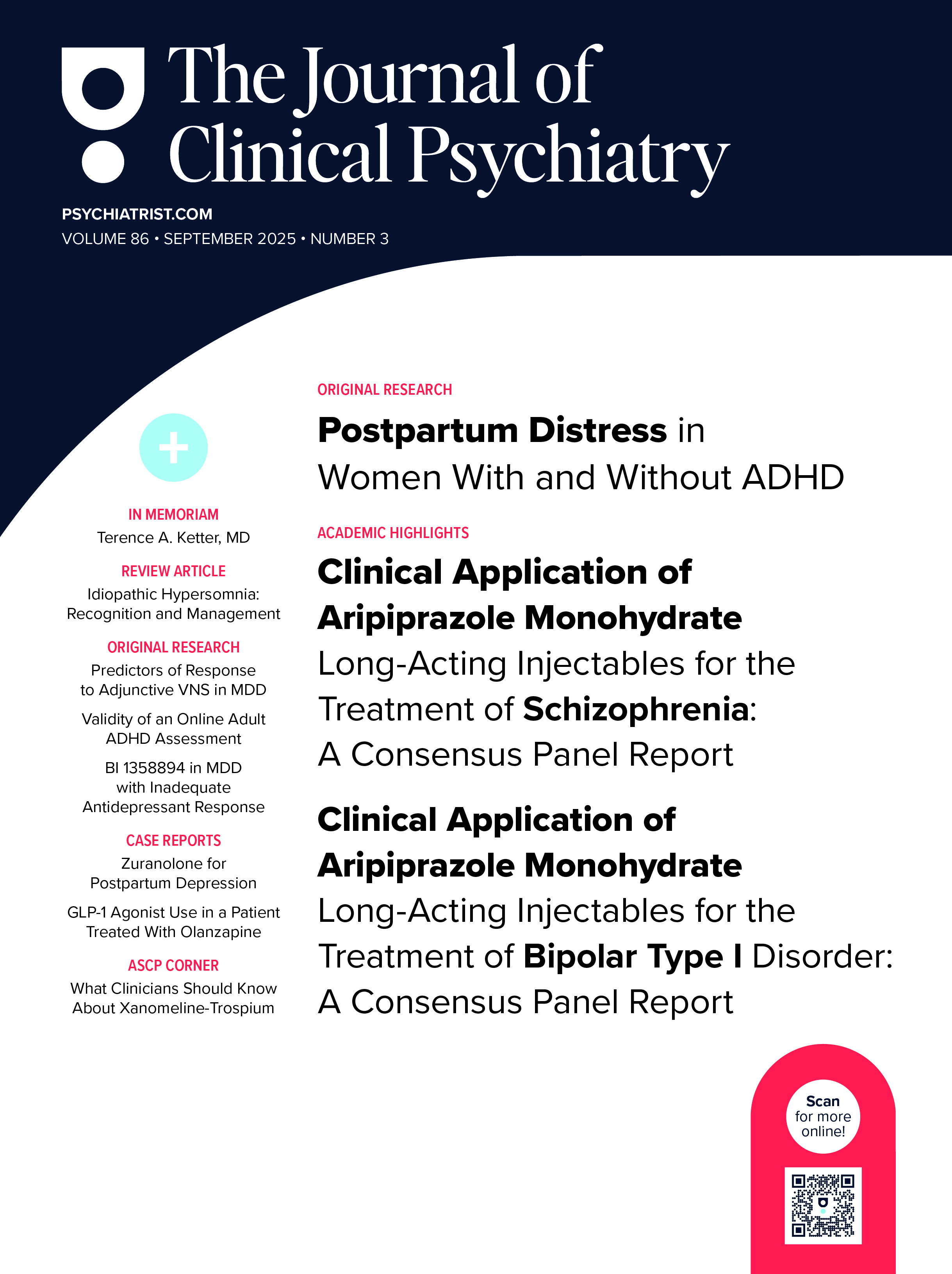ABSTRACT
Objective: Our objective was to characterize benzodiazepine prescribing changes among veterans with posttraumatic stress disorder (PTSD) and inform efforts to deimplement low-value prescribing practices.
Methods: This retrospective observational study used national Veterans Health Administration (VHA) administrative databases to examine annual period prevalence and incidence of benzodiazepine prescribing from 2009 through 2019 in veterans with PTSD. International Classification of Diseases (ICD-9/10) codes were used to identify PTSD. Temporal trends in discontinuation rates, incidence rates, and prevalent prescribing among patients newly engaged in PTSD care were measured.
Results: Benzodiazepine prevalence in veterans with PTSD declined from 31.3% in 2009 to 10.7% in 2019, and incidence decreased from 11.4% to 2.9%, along with a 30% decrease in daily doses. Increasing discontinuation rates accounted for 21.0% of the decline in prevalence, while decreasing incidence among existing patients accounted for 36.8%, and decreased prevalence among new PTSD cohort entrants accounted for 42.2%. Women received benzodiazepines more commonly than men (odds ratio [OR] = 1.67; 95% CI, 1.64–1.70). The proportion of older adults increased over time among both existing (2009: 14.5%; 2019: 46.5%) and new (2009: 8.6%; 2019: 24.3%) benzodiazepine recipients.
Conclusions: Benzodiazepine prescribing in VHA among veterans with PTSD showed changes driven by decreases in prevalence among new PTSD cohort entrants, with smaller changes in discontinuation and decreased incidence among existing patients. Educational initiatives may have curtailed benzodiazepine prescribing through promotion of effective alternative treatment options and supporting discontinuation through various tapering strategies. These initiatives offer resources and lessons to other health care systems to deimplement inappropriate benzodiazepine prescribing and other potentially harmful practices through patient-centered approaches that promote viable treatment alternatives.
Members Only Content
This full article is available exclusively to Professional tier members. Subscribe now to unlock the HTML version and gain unlimited access to our entire library plus all PDFs. If you’re already a subscriber, please log in below to continue reading.
References (26)

- Holder N, Woods A, Neylan TC, et al. Trends in medication prescribing in patients with PTSD from 2009 to 2018: a national Veterans Administration study. J Clin Psychiatry. 2021;82(3):20m13522. PubMed CrossRef
- Spelman JF, Hunt SC, Seal KH, et al. Post deployment care for returning combat veterans. J Gen Intern Med. 2012;27(9):1200–1209. PubMed CrossRef
- US Department of Veterans Affairs and US Department of Defense. VA/DoD Clinical Practice Guideline for the Management of Posttraumatic Stress Disorder and Acute Stress Disorder. 2017. Department of Veterans Affairs website. https://www.healthquality.va.gov/guidelines/MH/ptsd/VADoDPTSDCPGFinal012418.pdf. Accessed April 1, 2021.
- Guina J, Rossetter SR, DeRhodes BJ, et al. Benzodiazepines for PTSD: a systematic review and meta-analysis. J Psychiatr Pract. 2015;21(4):281–303. PubMed CrossRef
- Lund BC, Bernardy NC, Alexander B, et al. Declining benzodiazepine use in veterans with posttraumatic stress disorder. J Clin Psychiatry. 2012;73(3):292–296. PubMed CrossRef
- Wells DL, Popish S, Kay C, et al. VA academic detailing service: implementation and lessons learned. Fed Pract. 2016;33(5):38–42. PubMed
- Program focuses on safe psychiatric medication. Department of Veterans Affairs (online) website. www.blogs.va.gov/VAntage/27099/program-focuses-safe-psychiatric-medication. Accessed May 10, 2021.
- Sandbrink F, Oliva EM, McMullen TL, et al. Opioid prescribing and opioid risk mitigation strategies in the Veterans Health Administration. J Gen Intern Med. 2020;35(suppl 3):927–934. PubMed CrossRef
- Hawkins EJ, Malte CA, Imel ZE, et al. Prevalence and trends of benzodiazepine use among Veterans Affairs patients with posttraumatic stress disorder, 2003–2010. Drug Alcohol Depend. 2012;124(1-2):154–161. PubMed CrossRef
- Agarwal SD, Landon BE. Patterns in outpatient benzodiazepine prescribing in the United States. JAMA Netw Open. 2019;2(1):e187399. PubMed CrossRef
- Gravely AA, Cutting A, Nugent S, et al. Validity of PTSD diagnoses in VA administrative data: comparison of VA administrative PTSD diagnoses to self-reported PTSD Checklist scores. J Rehabil Res Dev. 2011;48(1):21–30. PubMed CrossRef
- Quan H, Sundararajan V, Halfon P, et al. Coding algorithms for defining comorbidities in ICD-9-CM and ICD-10 administrative data. Med Care. 2005;43(11):1130–1139. PubMed CrossRef
- US Department of Agriculture. USDA website. https://www.ers.usda.gov/data-products/rural-urban-commuting-area-codes. Accessed April 16, 2021.
- Bernardy NC, Lund BC, Alexander B, et al. Prescribing trends in veterans with posttraumatic stress disorder. J Clin Psychiatry. 2012;73(3):297–303. PubMed CrossRef
- Lund BC, Abrams TE, Bernardy NC, et al. Benzodiazepine prescribing variation and clinical uncertainty in treating posttraumatic stress disorder. Psychiatr Serv. 2013;64(1):21–27. PubMed CrossRef
- JAMA Network. Less is more. JAMA Network website. https://jamanetwork.com/collections/44045/less-is-more. Accessed May 26, 2021.
- Prasad V, Ioannidis JP. Evidence-based de-implementation for contradicted, unproven, and aspiring healthcare practices. Implement Sci. 2014;9(1):1. PubMed CrossRefv
- Gressler LE, Martin BC, Hudson TJ, et al. Relationship between concomitant benzodiazepine-opioid use and adverse outcomes among US veterans. Pain. 2018;159(3):451–459. PubMed CrossRef
- Finley EP, Mader M, Haro EK, et al. Use of guideline-recommended treatments for PTSD among community-based providers in Texas and Vermont: Implications for the Veterans Choice Program. J Behav Health Serv Res. 2019;46(2):217–233. PubMed CrossRef
- PTSD Consultation Program. US Department of Veterans Affairs National Center for PTSD website. https://www.ptsd.va.gov/consult. Accessed May 30, 2021
- American Geriatrics Society Beers Criteria Update Expert Panel. American Geriatrics Society 2019 Updated AGS Beers Criteria for potentially inappropriate medication use in older adults. J Am Geriatr Soc. 2019;67(4):674–694.
- Bernardy NC, Lund BC, Alexander B, et al. Gender differences in prescribing among veterans diagnosed with posttraumatic stress disorder. J Gen Intern Med. 2013;28(suppl 2):542–548. PubMed CrossRef
- Bernardy NC, Lund BC, Alexander B, et al. Increased polysedative use in veterans with posttraumatic stress disorder. Pain Med. 2014;15(7):1083–1090. PubMed CrossRef
- Gerlach LB, Wiechers IR, Maust DT. Prescription benzodiazepine use among older adults: a critical review. Harv Rev Psychiatry. 2018;26(5):264–273. PubMed CrossRef
- Wong J, Murray Horwitz M, Bertisch SM, et al. Trends in dispensing of zolpidem and low-dose trazodone among commercially insured adults in the United States. JAMA. 2020;324(21):2211–2213. PubMed CrossRef
- Department of Veterans Affairs Pharmacy Benefits Management Academic Detailing Services. Department of Veterans Affairs website. https://www.pbm.va.gov/PBM/academicdetailingservicehome.asp. Accessed June 12, 2021.





